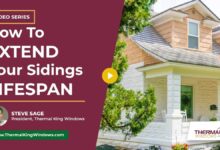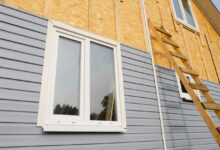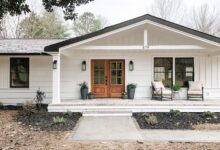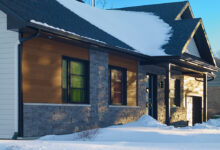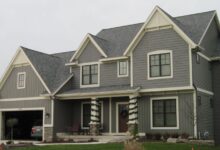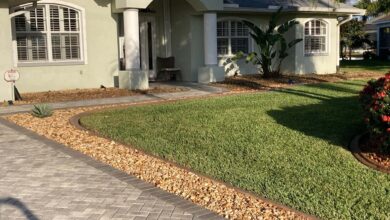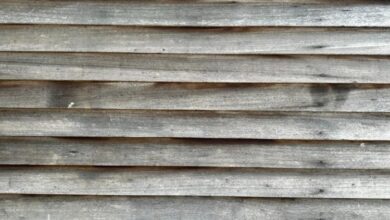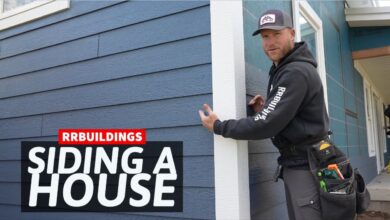5 Affordable Siding Options That Dont Compromise on Quality
5 Affordable Siding Options That Don’t Compromise on Quality: Upgrading your home’s exterior shouldn’t break the bank. This guide explores five budget-friendly siding choices that deliver exceptional durability, aesthetic appeal, and long-term value. We’ll delve into the pros and cons of each option, helping you make an informed decision that perfectly complements your home and budget.
From the cost-effective practicality of vinyl to the robust performance of steel, we’ll examine factors like initial investment, maintenance needs, lifespan, and energy efficiency. We’ll also consider the aesthetic versatility of each material, ensuring you find the perfect match for your home’s architectural style and personal preferences. Choosing the right siding is a significant investment, and this guide aims to equip you with the knowledge to make a confident and cost-effective choice.
Introduction
Choosing new siding for your home can be a significant investment, balancing cost-effectiveness with long-term value. This section clarifies what constitutes “affordable” and “quality” siding, setting the stage for exploring five budget-friendly options that don’t compromise on performance.
Defining “affordable” in the context of siding requires a holistic view. It’s not simply the initial material cost but also encompasses the expense of professional installation, potential ongoing maintenance, and the siding’s lifespan. A siding material with a lower upfront cost but requiring frequent repairs or replacement might ultimately prove more expensive than a slightly pricier option with greater longevity. Similarly, a less expensive material requiring specialized installation could negate any savings. Therefore, affordability is judged by the total cost of ownership over the material’s projected lifetime.
Quality siding, conversely, goes beyond mere aesthetics. Durable siding resists damage from impacts, weathering, and pests. Weather resistance means it effectively protects the home from moisture, extreme temperatures, and UV radiation. Aesthetically pleasing siding enhances curb appeal and complements the home’s architectural style. Finally, energy-efficient siding contributes to lower heating and cooling bills by providing superior insulation. This is often measured by the material’s R-value, which indicates its thermal resistance.
Siding Material Comparison
The following table compares several common siding materials based on initial cost, lifespan, and maintenance requirements. These values are approximate and can vary based on factors like material quality, geographic location, and installation costs.
| Siding Material | Initial Cost (per sq ft, approximate) | Lifespan (years, approximate) | Maintenance Requirements |
|---|---|---|---|
| Vinyl | $3-$8 | 20-40 | Low; occasional cleaning |
| Fiber Cement | $8-$15 | 50-80 | Moderate; periodic painting or staining may be needed |
| Aluminum | $6-$12 | 30-50 | Low; occasional cleaning and repainting if desired |
| Engineered Wood | $5-$10 | 25-40 | Moderate; requires regular painting and potential repairs |
Vinyl Siding
Vinyl siding presents a compelling option for homeowners seeking an affordable yet durable exterior cladding solution. Its popularity stems from a blend of cost-effectiveness, ease of maintenance, and a surprisingly wide range of aesthetic choices. While not as inherently long-lasting as some other materials, advancements in manufacturing have significantly improved vinyl siding’s durability and longevity, making it a viable choice for many budgets and climates.
Vinyl siding offers several advantages, primarily its affordability. Compared to wood, brick, or fiber cement, vinyl typically boasts a significantly lower upfront cost. This makes it particularly attractive for budget-conscious homeowners undertaking renovations or new construction. Its low maintenance requirements further contribute to its long-term cost-effectiveness. Unlike wood siding, which requires regular painting and staining, vinyl siding only needs occasional cleaning to maintain its appearance. Furthermore, vinyl siding is resistant to rot, insect infestation, and moisture damage, reducing the likelihood of costly repairs down the line. Aesthetically, vinyl siding offers considerable versatility, mimicking the look of wood, brick, or stone with a wide array of colors, textures, and styles.
High-Quality Vinyl Siding Brands and Their Warranties
Several reputable manufacturers produce high-quality vinyl siding known for its durability and longevity. These brands typically offer extensive warranties, providing homeowners with added peace of mind. For example, CertainTeed offers a lifetime limited warranty on its vinyl siding products, covering defects in materials and workmanship. Similarly, James Hardie, while primarily known for fiber cement, also offers vinyl siding with strong warranty coverage. These warranties often include protection against fading, cracking, and other common issues, demonstrating confidence in the product’s quality and resilience. Choosing a brand with a robust warranty is crucial for maximizing the return on investment and ensuring long-term value.
Case Study: Budget-Friendly Vinyl Siding Installation
A homeowner in a suburban area, aiming for a cost-effective exterior refresh, opted for vinyl siding installation. The existing wood siding on their 1,500 square foot home was showing significant signs of age and deterioration, requiring costly repairs or replacement. By choosing a mid-range vinyl siding option from a reputable brand like CertainTeed, they were able to achieve a complete exterior makeover for approximately 60% less than the cost of wood siding replacement, including professional installation. The project involved careful planning to minimize waste and optimize material usage, further reducing overall costs. The homeowner’s investment in vinyl siding not only enhanced the curb appeal of their home but also significantly increased its long-term value while staying within a strict budget. The project was completed within a reasonable timeframe and with minimal disruption to the homeowner’s daily life.
Fiber Cement Siding
Fiber cement siding offers a compelling blend of affordability and durability, making it a strong contender in the mid-range siding market. Its composition, a mixture of cement, cellulose fibers, and other additives, results in a product that’s significantly more resilient than vinyl while remaining considerably less expensive than options like wood or brick. This makes it an attractive choice for homeowners seeking a balance between cost and long-term performance.
Fiber cement siding’s inherent strength and resistance to damage from impacts, insects, and rot contribute to its cost-effectiveness over the siding’s lifespan. Reduced maintenance and repair needs offset the slightly higher initial investment compared to vinyl. Furthermore, its fire-resistant properties and ability to withstand harsh weather conditions add to its overall value proposition.
Fiber Cement Siding Installation and Cost Comparison with Vinyl
The installation process for fiber cement siding differs from that of vinyl. While vinyl siding can often be installed relatively quickly by DIYers, fiber cement requires more specialized tools and expertise due to its weight and the need for precise cutting and fastening. Professional installation is generally recommended for fiber cement, leading to higher labor costs compared to vinyl. However, the longer lifespan and lower maintenance requirements of fiber cement often make the overall cost comparable or even more economical in the long run. The initial investment may be higher, but the reduced need for future repairs and replacements can significantly reduce the total cost of ownership.
Fiber Cement Siding Manufacturer Comparison
The following table compares fiber cement siding from different manufacturers, illustrating price variations and performance ratings. Note that pricing can fluctuate based on location, retailer, and specific product features. Performance ratings are based on industry standards and manufacturer claims, and may vary depending on installation and maintenance.
| Manufacturer | Approximate Price Range (per square) | Fire Resistance Rating | Impact Resistance Rating |
|---|---|---|---|
| James Hardie | $3.50 – $6.00 | Class A (highest) | Excellent (Specific ratings vary by product) |
| CertainTeed | $3.00 – $5.50 | Class A | Good to Excellent (Specific ratings vary by product) |
| Nichiha | $4.00 – $7.00 | Class A | Excellent (Specific ratings vary by product) |
| Allura | $3.50 – $6.50 | Class A | Good (Specific ratings vary by product) |
Engineered Wood Siding
Engineered wood siding offers a compelling alternative to traditional wood siding, balancing the aesthetic appeal of natural wood with enhanced durability and resistance to the elements. It’s a popular choice for homeowners seeking a cost-effective yet high-quality siding solution that requires less maintenance. This section will explore the various types of engineered wood siding available, their price points, and their superior performance compared to natural wood.
Engineered wood siding is manufactured using wood fibers, resins, and waxes, compressed and treated to create a highly durable and water-resistant product. This process significantly improves its resistance to moisture damage, rot, and insect infestation compared to solid wood siding. The enhanced density and treatment provide a substantial barrier against the elements, reducing the likelihood of warping, cracking, or insect damage. This leads to lower maintenance costs and a longer lifespan compared to its natural counterpart.
Engineered Wood Siding Types and Prices
The price of engineered wood siding varies depending on the type, thickness, and finish. Generally, it falls within a mid-range price bracket, making it a more affordable option than some premium siding materials while offering superior performance to standard wood siding. However, precise pricing fluctuates based on regional factors and current market conditions.
- Wood-Plastic Composites (WPCs): These are a blend of wood fibers and plastic polymers. They offer a good balance of cost and performance, often exhibiting a realistic wood grain appearance. Price points typically fall in the mid-range for engineered wood siding.
- Fiber Cement Siding with Wood-Like Finish: While technically fiber cement, many manufacturers offer products with textured surfaces designed to mimic the look of wood grain. These tend to be slightly more expensive than WPCs due to their superior durability and fire resistance.
- High-Density Fiberboard (HDF) Siding: HDF siding is denser than standard fiberboard, providing improved strength and moisture resistance. Its price is typically comparable to, or slightly higher than, WPCs, depending on the specific product and finish.
Moisture and Insect Resistance of Engineered Wood Siding
Engineered wood siding’s resistance to moisture damage and insect infestation stems from its manufacturing process. The high density and the addition of resins and waxes create a material less susceptible to water absorption. This significantly reduces the risk of rot, swelling, and warping, common problems with natural wood siding. Furthermore, the dense structure makes it difficult for insects like termites to penetrate and infest the material. This is in stark contrast to natural wood, which is a natural food source for many insects and highly vulnerable to moisture damage if not properly treated and maintained.
Aesthetic Options in Engineered Wood Siding
Engineered wood siding offers a wide array of textures and colors to suit various architectural styles and homeowner preferences.
Imagine a home clad in WPC siding with a deep, rich brown finish, mimicking the appearance of aged cedar. The subtle texture creates a realistic wood-grain effect, enhancing the home’s rustic charm. Alternatively, consider a lighter gray or beige fiber cement siding with a smooth, painted finish, offering a modern and sleek look. The clean lines and even color create a contemporary aesthetic, perfect for a minimalist design. Some manufacturers even offer textured finishes that simulate the look of rough-hewn wood or even stone, offering exceptional versatility in design. The color palette ranges from classic earth tones to bold contemporary shades, allowing homeowners to personalize their homes’ exterior.
Aluminum Siding
Aluminum siding presents a compelling option for homeowners seeking a durable, low-maintenance, and affordable exterior cladding. Its inherent properties make it a strong contender in the siding market, offering a balance of cost-effectiveness and lasting performance.
Aluminum siding’s primary advantage lies in its remarkably low maintenance requirements. Unlike wood, which needs regular painting and sealing, or vinyl, which can be prone to cracking and fading, aluminum resists weathering and damage exceptionally well. A simple occasional washing is usually sufficient to keep it looking its best for many years.
Aluminum Siding Durability and Protective Qualities
Aluminum siding’s durability stems from its inherent strength and resistance to various environmental factors. It’s impervious to rot, insect infestation, and fungal growth, eliminating the concerns associated with wood siding. Furthermore, its resistance to fire adds a significant safety advantage, making it a preferable choice in areas prone to wildfires or where fire safety is a paramount concern. Its non-combustible nature contributes to a higher fire safety rating for the entire structure. The material’s resistance to dents and scratches, while not absolute, is significantly higher than vinyl or wood siding, contributing to its longevity.
Cost Comparison of Aluminum Siding Installation
The cost of aluminum siding installation varies depending on several factors, including the size of the house, the complexity of the installation (e.g., multiple gables, dormers), labor costs in the region, and the chosen style and finish of the siding. Generally, aluminum siding falls within a mid-range price bracket compared to other options. While it might be slightly more expensive than vinyl siding upfront, its longer lifespan and lower maintenance costs often make it a more economical choice in the long run. For instance, a 1500 sq ft home might see aluminum siding installation costs ranging from $8,000 to $15,000, while vinyl could range from $6,000 to $12,000 and fiber cement from $12,000 to $25,000. These figures are estimates and can vary considerably based on the previously mentioned factors. Labor costs are a significant component of the overall expense, with skilled installers commanding higher rates.
Aluminum Siding Installation Process
Proper installation is crucial to ensure the longevity and effectiveness of aluminum siding. A typical installation involves several key steps:
First, the existing siding must be removed, and the underlying wall sheathing inspected and repaired as needed. This often involves addressing any water damage or structural issues. Next, furring strips (thin wooden or metal strips) are often installed to create a ventilation gap between the siding and the house, preventing moisture buildup. This step is crucial for preventing rot and mold. After this, the aluminum siding panels are then installed, starting from the bottom and working upwards, overlapping each panel to ensure a watertight seal. Special attention should be paid to corners, windows, and doors, where proper flashing and caulking are essential to prevent water penetration. Finally, all trim pieces are installed to complete the look and provide additional protection. Professional installation is strongly recommended to guarantee proper execution of these steps and ensure the warranty is valid.
Steel Siding
Steel siding offers a compelling blend of affordability, durability, and aesthetic appeal, making it a strong contender among budget-friendly siding options. Its robust construction ensures long-term protection for your home, while its versatility allows for customization to match any architectural style.
Steel siding’s inherent strength and resilience provide exceptional protection against harsh weather conditions, including strong winds, heavy rain, and even hail. This durability translates to a significantly longer lifespan compared to some other materials, reducing the frequency of costly replacements and repairs.
Steel Siding’s Superior Strength and Durability
Steel siding’s exceptional strength stems from its composition. The material is highly resistant to dents, scratches, and impacts, making it ideal for homes in areas prone to severe weather. Unlike wood or vinyl, steel siding doesn’t rot, warp, or easily succumb to insect infestations. This inherent durability contributes to its significantly longer lifespan, often exceeding 50 years with proper maintenance. This longevity represents a substantial long-term cost savings compared to materials requiring more frequent replacement.
Fire Resistance of Steel Siding
Steel siding boasts excellent fire resistance, a critical factor in home safety. Its non-combustible nature significantly reduces the risk of fire spreading across the exterior of the house. This feature provides an additional layer of protection for your home and family, contributing to peace of mind and potentially lower homeowner’s insurance premiums. Many insurance companies offer discounts for homes with fire-resistant materials, like steel siding.
Steel Siding Lifespan and Maintenance
The lifespan of steel siding significantly surpasses that of many other affordable siding options. While vinyl siding might last 20-30 years, and engineered wood could last 25-40 years, steel siding, with proper maintenance, can easily last 50 years or more. Maintenance is minimal and typically involves periodic cleaning to remove dirt and debris. A simple power wash once or twice a year is usually sufficient to maintain its appearance and protect against rust. Occasional spot painting might be necessary to address minor scratches or chips, but overall, steel siding requires significantly less upkeep than other materials.
Steel Siding Finishes and Color Options
Steel siding offers a wide array of finishes and color options to suit diverse architectural styles and personal preferences. Homeowners can choose from various textures, mimicking the look of wood, stone, or stucco. The color palette is equally extensive, ranging from classic earth tones to bold, contemporary shades. The baked-on enamel finish provides superior protection against fading, chipping, and peeling, ensuring the siding retains its vibrant color for many years. For example, a homeowner might choose a deep, textured brown to complement a traditional home, while a modern home might be clad in sleek, gray steel siding with a smooth finish.
Last Word
Ultimately, selecting the best affordable siding hinges on a careful assessment of your individual needs and priorities. While cost is a crucial factor, remember that investing in quality materials and professional installation will yield long-term benefits in terms of durability, energy efficiency, and curb appeal. By weighing the advantages and disadvantages of each option discussed—vinyl, fiber cement, engineered wood, aluminum, and steel—you can confidently choose a siding solution that enhances your home’s beauty and value without exceeding your budget. Consider the long-term costs and the overall impact on your home’s aesthetic and energy performance to make the most informed decision.
